PROJECTS & ARTISTS
Ars Electronica - Digital Art and Magic Moments
The Magic Moments of Digital Art are manifold. Some of the works bewitch
the visitor with aesthetic translations of scientific phenomena, shedding
new light on the way how we are still always intertwined with the laws
of nature no matter how tricky our technology becomes.
Some beguile you by involving you in an interactive process that entangles
your senses in a playful way, bringing you close to the experience of
being part of the creative process itself.
Some just leave you stunning about the new ways of thinking that they
introduce and their new perspectives of the relation between man and
machine.
Some open your eyes with their critical reflections about social implications
and possible conflicts based on certain applications of technology.
They all help us to understand the dynamics and changes that are going
on around us; they help us to find our position in this new situation.
They encourage us to take things into our hands and to move from the
position of the mere consumer to the one of a creator.
Digital codes, programming languages, computers and electronic components are the tools as well as the material of digital art. But as soon as you engage with them, the technical setup disappears from attention, pushed away by their artistic momentum and the sensation of being involved in communication, exchange and magic moments.

|
Archive wall28 years of Ars Electronica means 28 years of innovative projects,
state-of-the-art technology, creative works of cyberart and astounding
future-oriented concepts. This dynamic large-format wall diagram
simultaneously serves as a portal to Ars Electronica’s digital
project archive and to documentations of the most important events
that took place in the cultural environment of Ars Electronica
in Linz/Austria. This includes the |
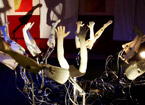
|
ArabesqueArabesque by Peter William Holden (UK) is a robotic performance using life sized cast human body parts. Like a grotesque ballet the arms and legs move to the rhythm of the Blue Danube waltz like the petals of a flower and produce a kaleidoscope of paradoxically beautiful patterns. Supported by FESTO and by Shanghai CompAir Compressor Co., Ltd |
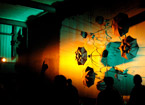
|
AutogeneThe installation Autogene by Peter William Holden (UK) is a cocktail of eight umbrellas, air hoses and electrical cables to a central computer which enables “AutoGene” to produce a choreographed dance to “Singin’ in the Rain” and transforms the mundane umbrellas into magical animated objects. Supported by FESTO and by Shanghai CompAir Compressor Co., Ltd |
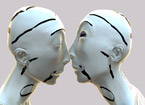 |
s.h.es.h.e. by Natasa Teofilovic (RS) plays with virtuality and reality. The borders between them begin to blur. The five characters try to establish contact with human beings on the other side of the screens and want to communicate with them. When they wander from monitor to monitor, they seem to traverse the real world that exists in the gaps between the screens. |

|
White Lives on SpeakerWhite Lives on Speaker is a hybrid installation by Yoshimasa Kato and Yuichi Ito (both JP) producing ever-changing sculptures made through sound and vibrations on a speaker diaphragm. Potato starch dissolved in water is jumping on a speaker and when stimulated, the dissolved starch becomes solid, yet returns to liquid when the stimulation is stopped. Supported by Chukyo University |
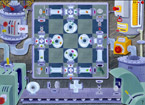
|
La Pâte à SonLa Pâte à Son – which can be translated as ‘sound dough’ – is a sound toy and compositional tool by the artist group LeCielEstBleu (FR), that was conceived to encourage musical experimentation. In the Pâte à Son factory interface, two reservoirs of dough generate a continuous flow of musical loops, from scales to simple tunes. The goal is to create music by making a mess of the established order. Users can divert and direct the musical flow by placing pipes from the conveyor belt on to the central checkerboard above. In addition to neutral transporter pipes, there are eleven instrumental pipes that give voice – a flute, a guitar, a human singing… – to the silent notes. |
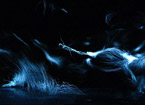
|
Camera Lucida: Sonochemical ObservatoryCamera Lucida: Sonochemical Observatory by Dmitry Gelfand and Evelina Domnitch (both US) directly transforms sound waves into light by employing a phenomenon known as sonoluminescence: ultrasound within a liquid triggers micro-bubble implosions accompanied by temperatures as high as are found on the Sun and light emissions in the shape of sound waves. Developed in collaboration with scientists in Japan, Germany, Belgium, and Russia. |
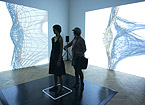
|
Se Mi Sei VicinoSe Mi Sei Vicino by Sonia Cillari (IT) is a participant-responsive environment exploring the topic of human body as an interface. By touching the person in the middle of the sensorfloor, sound and visuals are generated and the visitors get confronted with the idea of what skin consciousness is, how presence, proximity and touch can re-direct the way we understand ourselves and regulate our relations with the others. Produced by Netherlands Media Art Institute, Montevideo/Time Based Arts, Interface developed by STEM (Studio for Electro-Instrumental Music) with the support of Rijksakademie van beeldende kunsten, Amsterdam. |
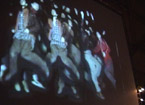
|
Jump!Jump! is an interactive video installation by Yacine Sebti (BE/MA) that offers a visual space of creation to the visitor. The body of the user becomes a brush by jumping in front of the screen. This work allows that more than just one visitor can interact with. The creation of a collective leap can have different forms and shapes. Co-production: iMAL (www.imal.org) |
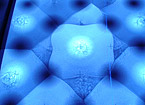
|
Ene-geometrixEne-geometrix by Sekine Masato (JP) is an aestheometry generation device using a liquid heat convection phenomenon. By producing temperature differences between a fluid and its surroundings, the user can create fascinating patterns. Peltier Modules, arrayed on a grid, warm or cool the fluid. When the temperature of the fluid sharply diverges from that of its surroundings, the pattern is obliterated by currents. Supported by Keio University and Kohiyama lab |
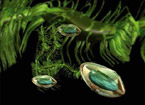 |
MU herbariumMU herbarium by Catherine Nyeki (FR) proposes the intuitive discovery of a “sensitive microscope” a sort of tactile laboratory formed by a hundred virtual, mobile and musical organic inhabitants: “the trees of light-bug, the vegetal clocks, the animal plants”. Based on imaginary laws of physics, the characters constituted by “bodies-node” and by “branch arms” can be observed or transformed by the visitors at any moment thanks to an alphabet of modular forms. This work of art offers a true creative experience where the visitor is invited to become the hero of a personal “hand theater”. |
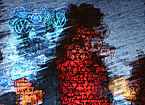
|
MemecryMemecry by Aaron Koblin (US) is an electronic installation which
creates images of the viewer from a pallet of corporate logos
in real-time. As the piece is viewed, the appearance of corporate logos reveals a direct
image of the user (reversed mirror) by color accumulation and
shape. The projector is sponsored by MITSUBISHI ELECTRIC |
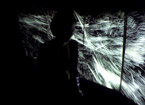
|
Will.0.W1spWill.0.W1sp by Kirk Woolford (UK) is an interactive installation exploring our ability to recognise human motion without human form. It uses particle systems to create characters or “whisps” with their own drifting, flowing movement, but which also follow digitised human movements. Will.0.W1sp invites visitors to chase after virtual, intangible characters which continually scatter and reform just beyond their reach. Sound: Carlos Guedes |

